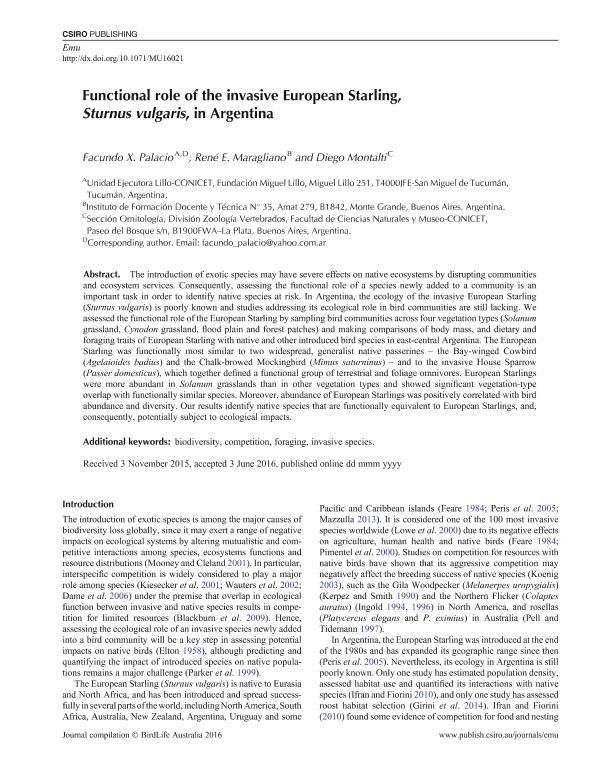Artículo
Functional role of the invasive European Starling, Sturnus vulgaris, in Argentina
Fecha de publicación:
06/2016
Editorial:
Csiro Publishing
Revista:
Emu
ISSN:
0158-4197
Idioma:
Inglés
Tipo de recurso:
Artículo publicado
Clasificación temática:
Resumen
The introduction of exotic species may have severe effects on native ecosystems by disrupting communities and ecosystem services. Consequently, assessing the functional role of a species newly added to a community is an important task in order to identify native species at risk. In Argentina, the ecology of the invasive European Starling (Sturnus vulgaris) is poorly known and studies addressing its ecological role in bird communities are still lacking. We assessed the functional role of the European Starling by sampling bird communities across four vegetation types (Solanum grassland, Cynodon grassland, flood plain and forest patches) and making comparisons of body mass, and dietary and foraging traits of European Starling with native and other introduced bird species in east-central Argentina. The European Starling was functionally most similar to two widespread, generalist native passerines -The Bay-winged Cowbird (Agelaioides badius) and the Chalk-browed Mockingbird (Mimus saturninus) -And to the invasive House Sparrow (Passer domesticus), which together defined a functional group of terrestrial and foliage omnivores. European Starlings were more abundant in Solanum grasslands than in other vegetation types and showed significant vegetation-Type overlap with functionally similar species. Moreover, abundance of European Starlings was positively correlated with bird abundance and diversity. Our results identify native species that are functionally equivalent to European Starlings, and, consequently, potentially subject to ecological impacts.
Palabras clave:
Biodiversity
,
Competition
,
Foraging
,
Invasive Species
Archivos asociados
Licencia
Identificadores
Colecciones
Articulos(UEL)
Articulos de UNIDAD EJECUTORA LILLO
Articulos de UNIDAD EJECUTORA LILLO
Citación
Palacio, Facundo Xavier; Maragliano, René E.; Montalti, Diego; Functional role of the invasive European Starling, Sturnus vulgaris, in Argentina; Csiro Publishing; Emu; 116; 4; 6-2016; 387-393
Compartir
Altmétricas




